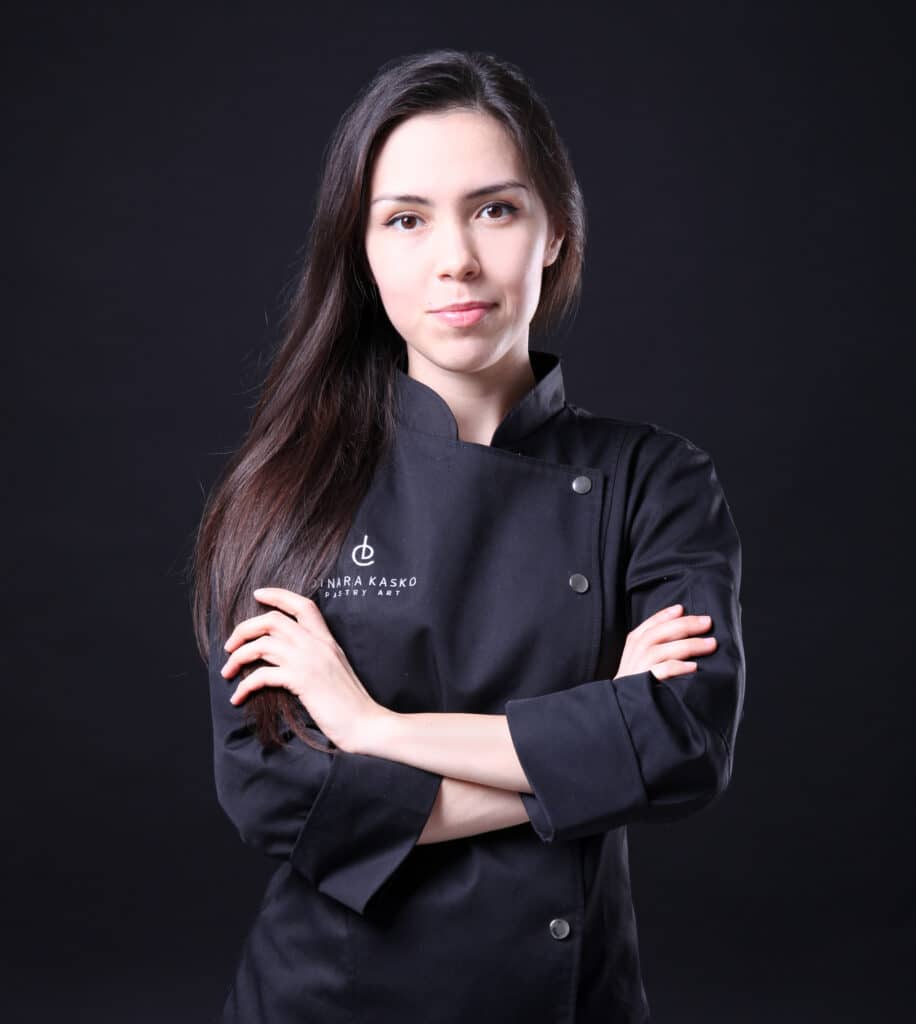My Mother’s Day cake this year was a special treat: slicing into it revealed a multi-layered dessert of vanilla cake, lemon curd caramel, and mango gelée, topped with tesselating swirls of mango mousse and flecks of gold. Its impressive design was thanks to a silicone mold created through pastry chef Dinara Kasko’s 3D-printed cake process. Her unique method has inspired fans around the world with its stunning artistry.
That’s how it reached me—after Russia’s invasion of Ukraine, San Diego author and pastry chef Krystina Coles decided to make cakes using Kasko’s molds as a fundraiser for Ukraine relief. Coles is part of a global community following the pastry star’s updates, while Kasko herself is now dedicating her own efforts to this greater cause.
All photos courtesy of Dinara Kasko
Growth in Innovation
Just a few years ago, Dinara Kasko was a young mother who’d left her job at a design firm to take care of her newborn daughter. She began making some basic cakes at home, but her creativity needed something more. After trying out store-bought molds, she experimented with a friend’s CNC milling machine, which she could use to create her own 3D designs for cakes. Eventually she invested in an Ultimaker 3D printer and moved her work to a studio outside her home. Kasko’s pastries began to get noticed, and she quickly grew to international fame, doing tours and master classes around the world.
Her modern designs have been inspired by many sources—origami, aspects of her everyday life, requests for special projects. She loves lines, bold colors, and geometric elements. New equipment and opportunities are always welcome to her. As she told me, “technology is always changing,” and she loves challenging herself to push the boundaries of architectural capabilities in pastry.
Dinara Kasko’s 3D-Printed Cake Process
After the many creations she’s made, Kasko amusingly says the process is “simple”—though it takes several days and must be started over if any little thing gets bumped or goes awry.
A cake starts out as a sketch of an idea she has, and then she makes a computer model of it.
Next, she uses her computer template to make a plastic 3D print of the shape that the cake will take on. Depending on the complexity of the design, this can take up to nine days.
Kasko then makes a mold around the 3D-printed structure with silicone.
When it’s time to bake, the mold can be filled with a variety of ingredients—typically lined with a mousse and layered with fruit purées, nuts, cake, cookie, or brownie. Then it’s chilled and set, and afterwards the cake must be carefully removed from the silicone mold. Now it’s ready for any external finishing touches. This might be a shiny glaze, a finely airbrushed gradient of colors, or edible handmade embellishments.
The result is a dessert that’s as interesting to the eyes as it is to the palette.
It’s a process that takes imagination, hi-tech equipment, and a good amount of time (but you can watch it all in under a minute in this time-lapse video). Chefs both amateur and professional who’ve wanted to try out these unique pastry shapes have been able use Kasko’s molds and personalize their contents’ colors and flavors.
Adapting Through Changing Circumstances
As her business has grown, this ever-more experienced pastry chef has learned what types of forms work best as well as what customers like. “It’s not only about what I want to do, but it’s about what people want to have.” Understanding customer demand and allowing it to fuse with her own vision have really propelled her forward on the world market. Locally, she has often taken requests for one-of-a-kind desserts that clients could help dream up themselves, and some of her special projects have been for top pastry magazines.
Kasko with cakes from some of her best-selling molds
In February, though, everything changed for Dinara Kasko. She has heart-achingly watched as her previously vibrant home city of Kharkiv has turned into a war zone, with beloved landmarks and neighborhoods destroyed before her eyes. A country under attack has made her reevaluate how she can best put her talents to use.
Within the current environment, Kasko has shifted her 3D-printing work away from pastry design in order to make medical and military equipment for those on the front lines. She’s also directed sales from her online classes and cake molds to the efforts in her home country. With the funds she’s raised, she has purchased food, medicine, supplies, and evacuation transport in devastated Ukrainian communities.
Hope in Resilience
If others ask Dinara Kasko for advice, she’ll tell them, “Do not be afraid, take risks, find like-minded people and get creative.” Her outlook is aptly suited not only to business and baking, but now to the broader circumstances as well. Sometimes creativity can be harnessed for unexpected situations. And sometimes innovation is more than trying new things—it’s also forging connections, building pathways, and rising up to meet difficult changes. Even under awful conditions, progress can be made. Whatever happens, Kasko says, “the key is not to stop.”
To learn more about Kasko’s work or contribute to her cause, see her taplink site.

